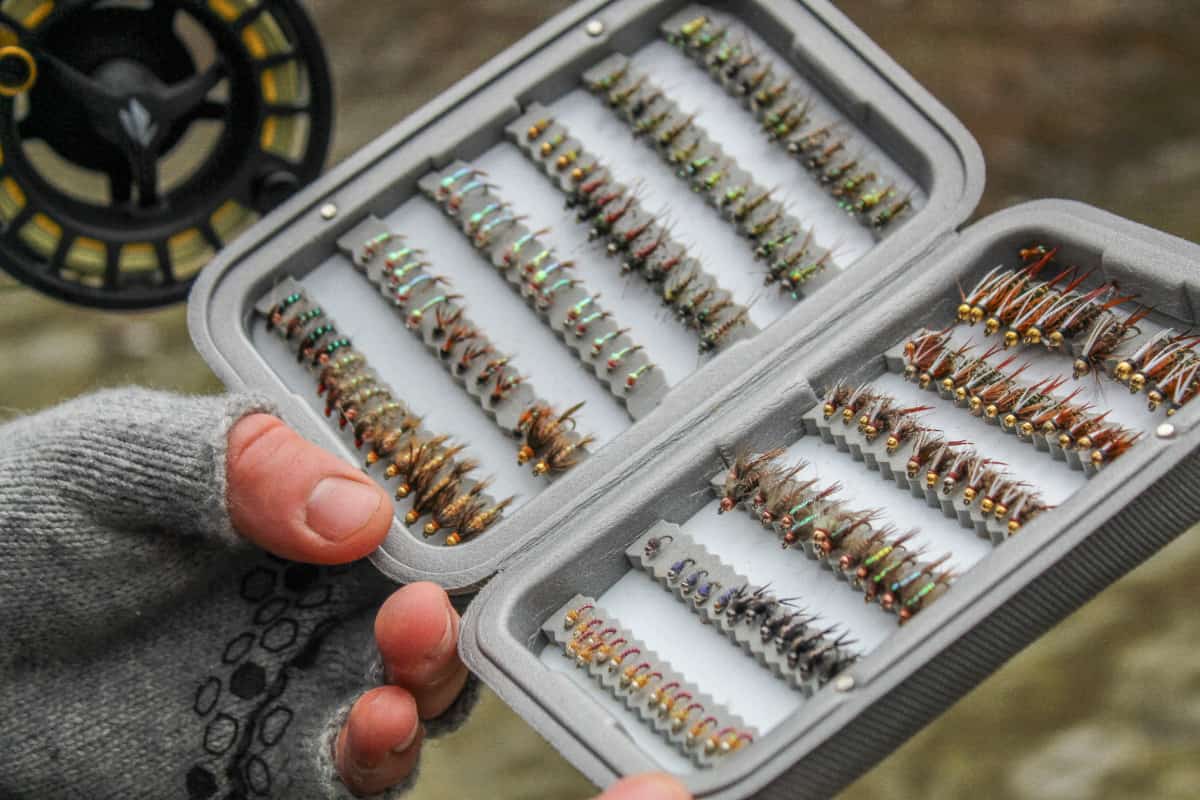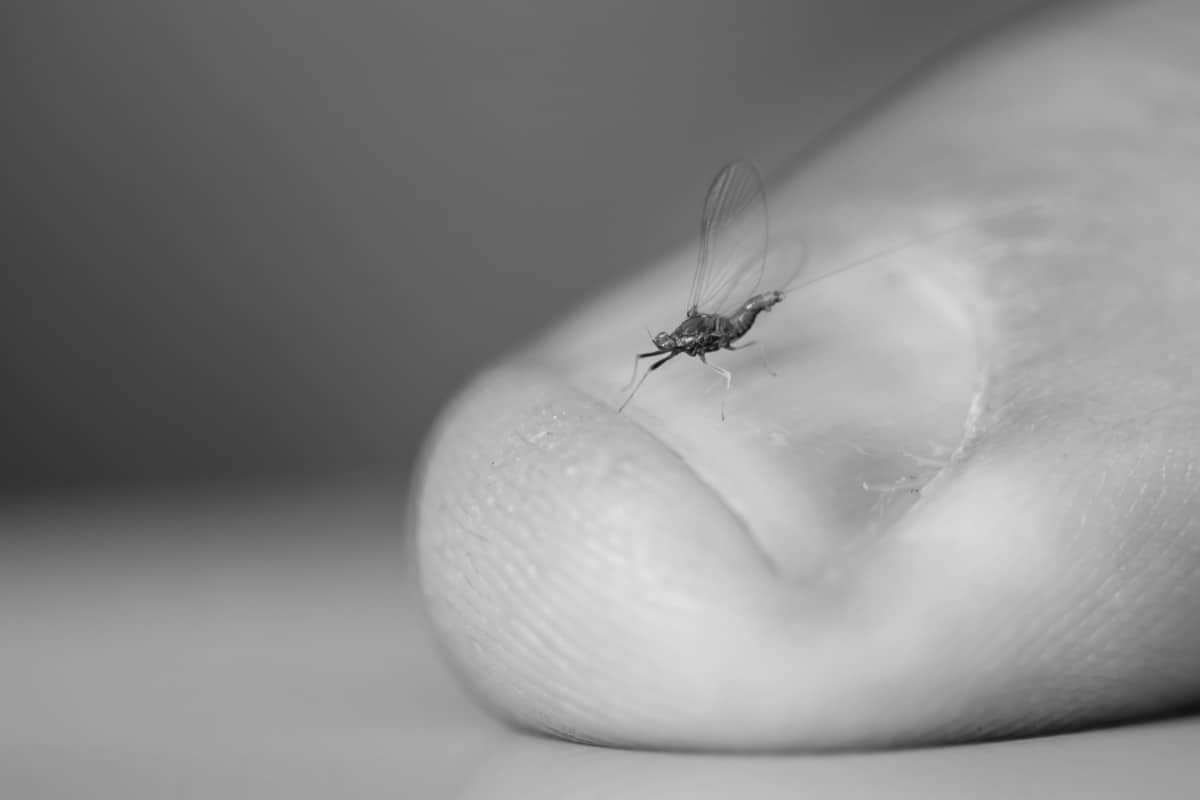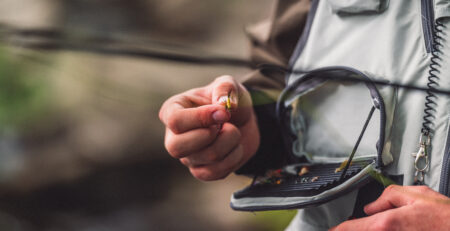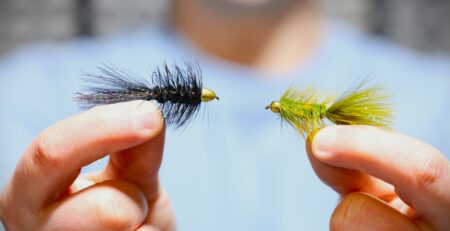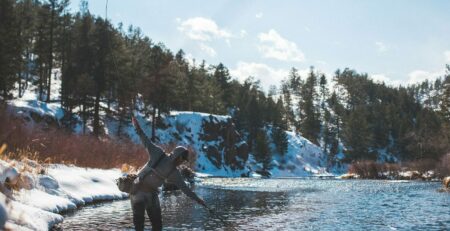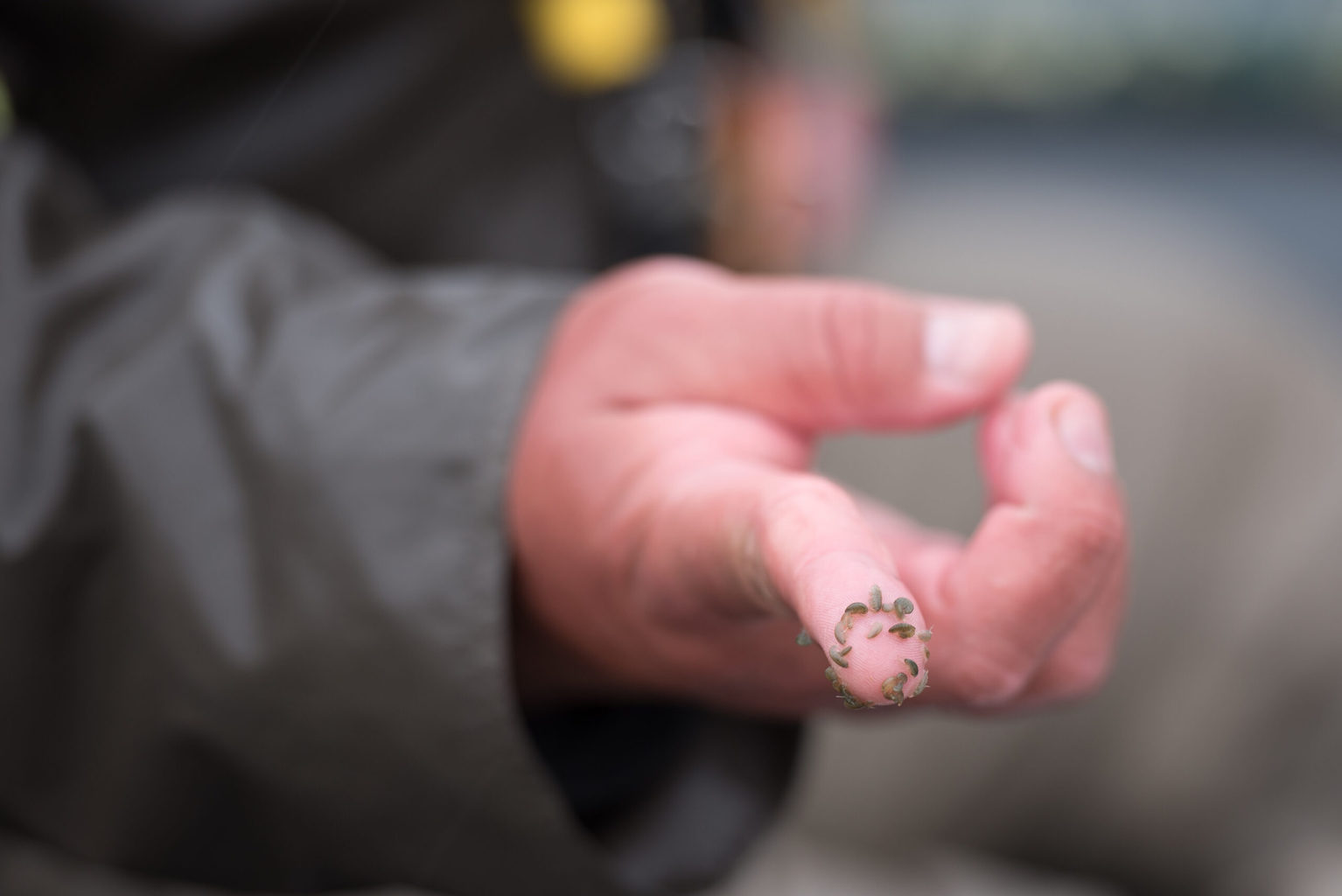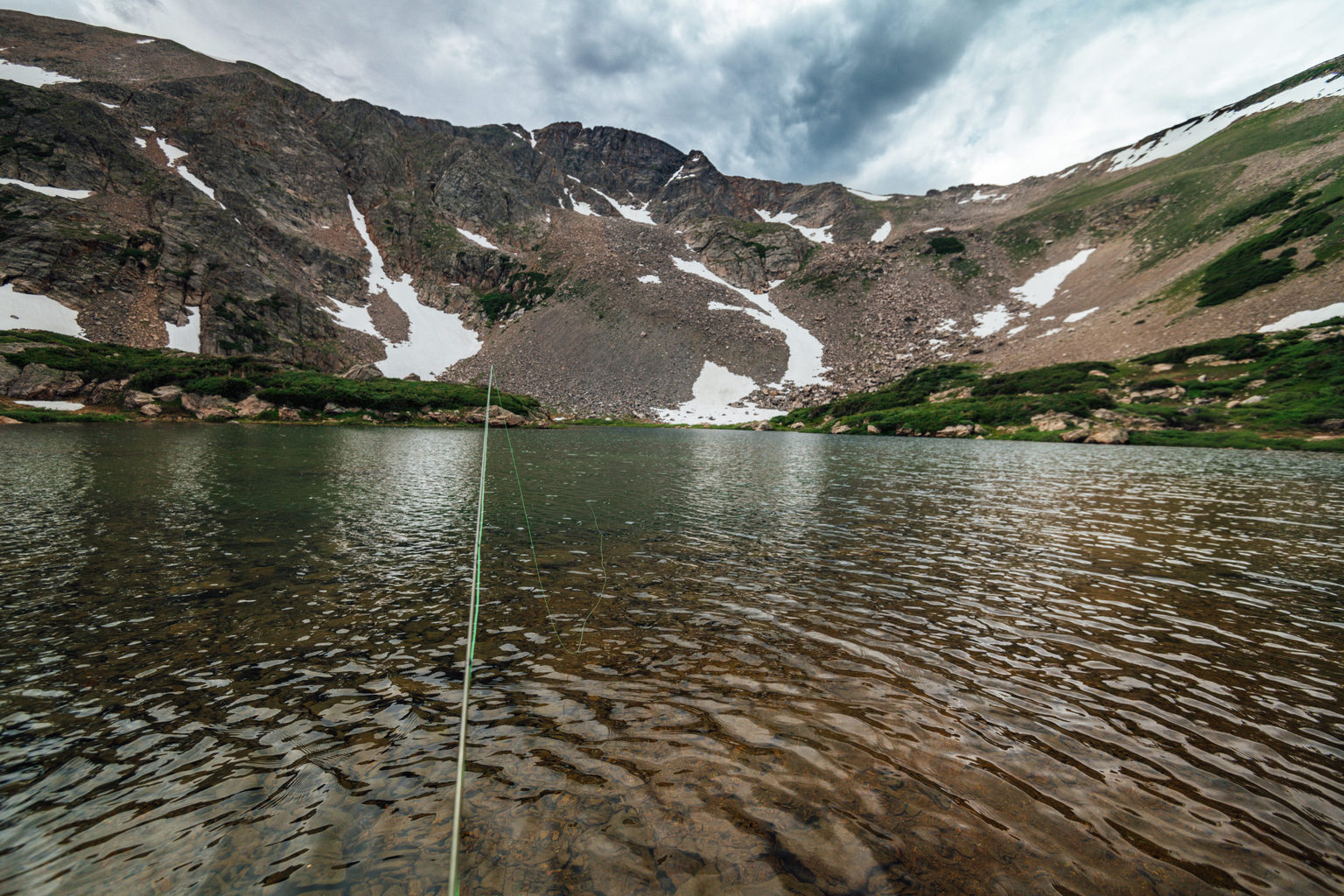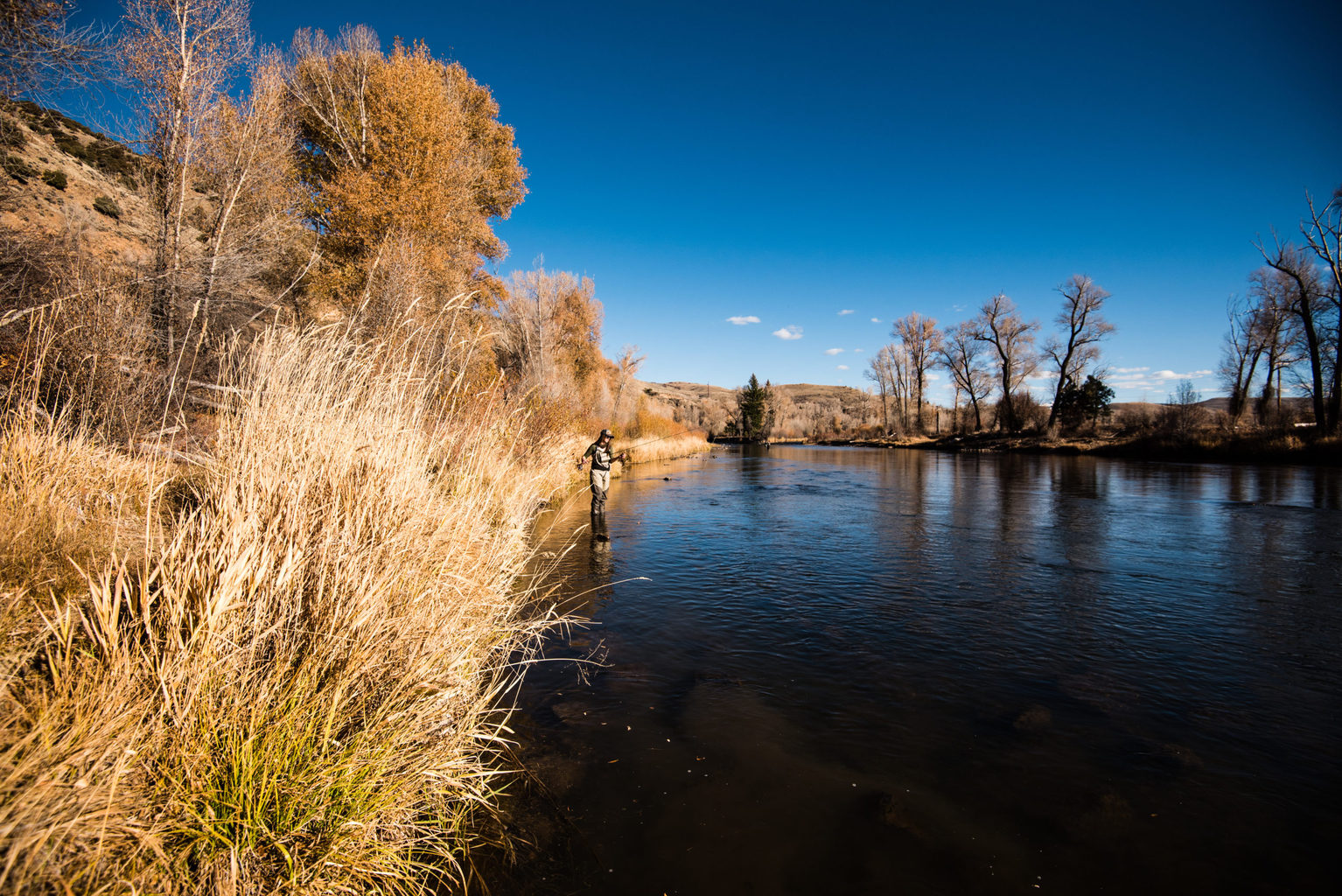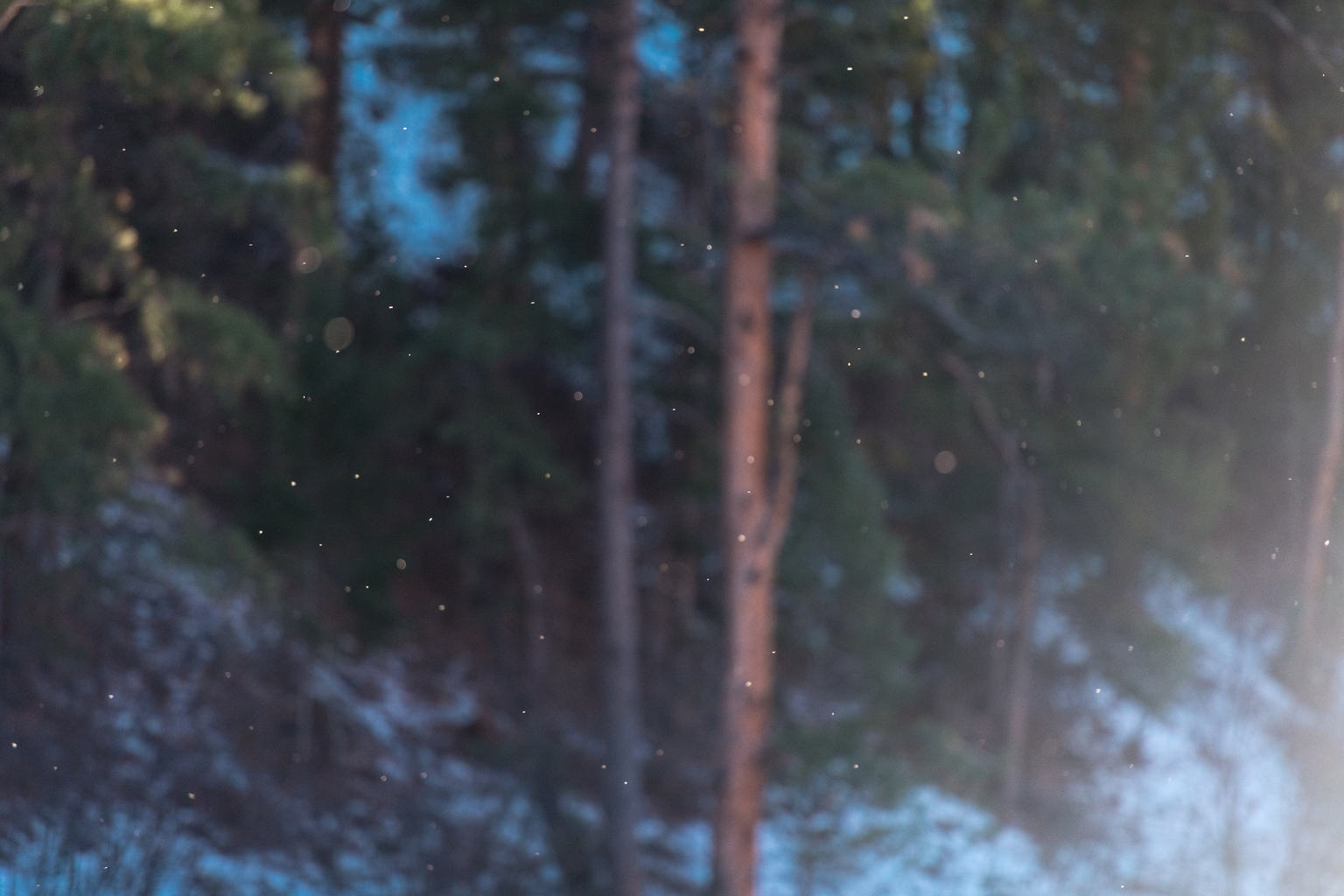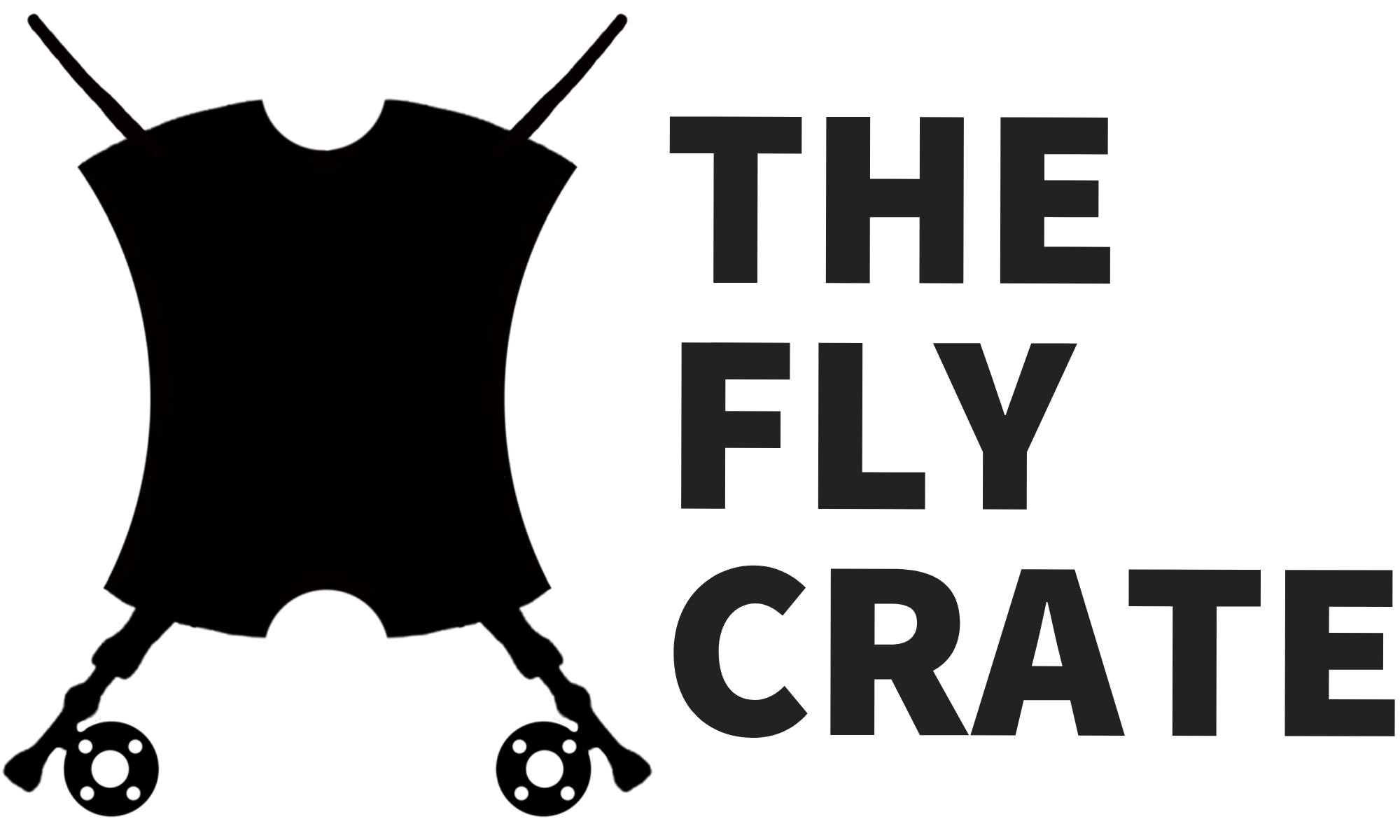Fly Fishing Hook Sizes: How To Choose The Right Size
It can be confusing to start fly fishing when there are so many different fly fishing hook types and sizes to choose from, especially when other anglers start mentioning 1.5x or 2x long shanks or #2/0 streamers.
Here is everything you need to know about fly fishing hook sizes to pick the best fly hook size for your needs.
In this article, we are primarily speaking about trout flies and the size fly that you would use when fly fishing for them.
Table Of Contents
- How Are Fly Fishing Flies Sized?
- Hook Sizes For Types Of Flies
- Does Fly Size Matter?
- What Size Fly Size Is Best For Trout Streams
- What Fly Fishing Flies Are Best For Beginners?

How Are Fly Fishing Flies Sized?
Fly fishing flies are sized in even numbers. The larger the number the smaller the hook size. Typically, in trout flies, the largest size hook a fly fisherman will use is a size #2 streamer or nymph. As the number of hook sizes increases, the fly sizes are smaller to represent small insects and food sources. These small flies can go all the way to a size #32. They are absolutely tiny and it is hard to believe that fish can even see them.
A hook size formula is used to measure a hook. The formula measures the length of the shaft of the hook, in addition to the hook gap or distance between the hook shank and the throat of the hook.
Hook weights are different for various types of fly patterns. For example, dry fly hooks that are the same size as nymph hooks, are tied on lighter gauged steel hooks. Nymph and streamer hooks are made with heavy steel that doesn’t bend easily. Depending on what part of the life cycle the fly is imitating, there are dozens of shapes and styles of hooks.
You will encounter large streamer and bass flies in some strange sizes with a “/0” behind the number such as #2/0. This is pronounced a “two aught” hook, which refers to the thickness gauge of the wire. These are massive hooks where the larger the number the larger the hook size. For example, a size #2/0 is larger than a size #1/0.

What Is A Hook Gap?
The hook gap is the distance between the point of the hook and the shank of the hook. This gap determines that numbered hook size. For example, a size #2 hook will have a much larger gap compared to a tiny size #20.
A larger hook gap does make it easier to firmly hook a fish. In fact, many fly fishermen prefer to use fly hooks with wider hook gaps simply because it makes it easier to catch a fish. For instance, anglers who like to use the tight-line or European nymphing technique prefer barbless hooks with an extra wide gap for higher hook-up rates.
But, like jeans in the fashion world, a lot of fly fishing brands that manufacture hooks tend to have hook gaps that are different from one another. Basically, a size #12 hook from one brand could be smaller or larger than the other brand.

What Is A Hook Shank?
The hook shank is the section of the hook, which is typically straight, directly behind the eye to just before the bend.
Hook shanks will vary in size depending on the type of hook and whether or not it features an extra-long shank. These special types of fly hooks feature long shanks labeled as 1.5x (1.5 times) or even 2x (2 times) the length of a standard hook. Most of these extra-long hooks are commonly used for elongating bodies on nymphs, dry flies, and streamer flies. The hook gap size is not affected by increased shank lengths.

What Is A Hook Barb?
The hook barb is a small, sharp piece of the hook that is manufactured to stick up at a slight angle just before the pointed end of the hook. This barb allows the fish to be hooked onto the lure or fly but prevents the fish from slipping off.
Barbed hooks make it much easier to catch and land fish. However, it does cause damage to the fish when fly fishermen remove the fly from their mouth. It is common for fly fishermen who practice catch-and-release to pinch these barbs down to create a barbless hook so it’s safer for the fish. Fly fishing flies can either come with a barb or are sold barbless, meaning the hook does not have a barb and never did.

What Is A Hook Eye?
The hook eye, or “eye of the hook”, is the small circular end of the hook where your line is fed through the center of the circle and tied to the fly. This small circular section is manufactured into hooks using the same wire the rest of the hook is made from.
Fly fishermen use a variety of knots to connect the fly to their fly leader such as the Davy Knot, Clinch Knot, and Improved Clinch Knot.
When it comes to what leader or tippet size to use when fly fishing, you can use any size line as long as it fits through the eye of the hook. The most popular leader and tippet sizes used to fly fish nymphs, streamers, and dry flies range from a size 3x to 6x. Sizes 3x and thicker are perfect for casting larger flies while 4x and thinner are ideal for casting nymphs to tiny dry flies whereas size 6x would be ideal.

Hook Sizes For Types Of Flies
Hooks size #2 to size #6 are usually perfect for salmon flies, stoneflies, baitfish, grasshoppers, and golden stoneflies.
Hooks size #8 to size #10 are usually imitating larger mayflies, eggs, small baitfish, leeches, and smaller stoneflies.
Hooks size #12 to size #16 are usually imitating a wide variety of mayflies, caddis flies, small stoneflies, small terrestrials, and midge clusters. Here are a few hatches that these hook sizes are known for: yellow sallies, Pale Morning Duns (PMDs), October Caddis, Green Drakes, March Browns, Quill Gordons, Sulphurs, ants, crickets, beetles, and Callibaetis.
Hooks size #16 to size #20 are usually imitating a wide variety of smaller mayflies, caddis flies, and larger midges. Here are a few hatches that these hook sizes are known for: Pale Morning Duns (PMD’s), Mother’s Day Caddis, Longhorn Caddis, Blue Winged Olives (BWO’s), Tricos, and midges.
Hooks size #22 to size #32 are usually imitating tiny mayfly species and midges.
Recommended Reading: Quick Guide To Tippet And What Sizes To Use

Does Fly Size Matter?
Choosing the correct fly size for a specific hatch is important, but fly size does not always have to be exact. You can be a size smaller or larger than the natural insect’s size and still catch fish. Fly fishermen do have more success when the fly fishing flies are appropriately sized to the food found on or in the water.
As a general rule of thumb, insect hatches at the beginning of the fly fishing season are bigger. This allows the presentation of a larger fly. As hatches progress through the summer and into fall the insects get smaller and fewer between.
Do Trout Get Used To Seeing The Same Flies?
Yes, trout become conditioned to being presented with the same fly over and over again. Fish become more selective as the season goes on. Trout eat flies that range in different sizes early into the season because they are hungry from the winter, and they haven’t seen many fly fishing flies in the off-season.
For example, in spring they might eat a Pat’s Rubber Leg in sizes #6-10. This is because there are many species of insects in the water that range in those sizes. However, by August, they might be selectively eating smaller flies. This is the result of being hooked throughout the summer in addition to there being fewer insects in the water. So there might be only mayflies that are size #18 at the time of the year.
A hard and fast rule is that insects hatching over a longer period of time generally become smaller as the hatch progresses. For example, Pale Morning Duns (PMD’s) on Idaho’s South Fork of the Snake River change sizes from month to month. In July when the hatch starts, PMD’s are the same size as a size #14 or #16 dry fly. By the time the Pale Morning Duns hatch is over in August, the PMD’s are a size #18 and the fish are very picky. In fact, smaller flies that are sparsely tied with a slimmer profile work the best.
Trout spend much of the season in the same areas. After being hooked several times they become conditioned just like any other animal. This makes them more selective, which means feeding fish will key in on specific-sized insects in particular colors. They can even key into specific parts of the hatch such as the emerging pupa or crippled adults that couldn’t take flight. Flies fished with a poor presentation or flies sized too big are dead giveaways to weary fish. During the late season, you want to downsize when trout refuse your fly.

What Size Fly Size Is Best For Trout Streams
The most popular size of flies is by far a size #14 hook. Size #14 flies are commonly used for nymphs and dry flies nearly year-round. Streamer flies between size #8 and size #10 are the most popular.
Often times we choose patterns that have catchy names and look attractive in the fly tying vice. It is easy to overlook crucial factors when fly fishing and choosing the correct fly sizes.
The first factor is choosing the correct size of fly based on the natural insects you are seeing. The aquatic insects on or around the water dictate what size hook or fly you should choose. If you are wrong on either of these two points, it makes catching fish very difficult. In fact, most anglers tend to choose flies that are too big.
Second, is the depth at which you fish the fly or whether you want it floating on the surface.
We are going to cover everything you need to know about choosing the correct hook size and fly pattern.
When starting out fly fishing a trout stream for rainbow trout, select basic flies for matching the hatch. Matching the hatch is a generic term that means we are trying to match our flies to the natural insects that are present on the river or in the river system.
Recommended Reading: What Color Variations You Should Use For Fly Fishing Flies And When

How To Match The Hatch
Fly fishing for trout requires patient observance of what is happening around you on the river. When I first pull up to a stream to fly fish, I will rig my rod without flies. I take a casual stroll along the river banks, and shake stream side bushes to see what insects come out of the bushes and fall onto the water’s surface. This stream side reconnaissance is a critical step in catching trout and figuring out what fly to use. Even if you don’t know aquatic insects, you can match the general profile and the specific size of the insects that are present that day.
Straining The Water For Insects
If there aren’t any bugs in the bushes, then the next best thing is to look for insects in the water column and substrate of the river. We can collect insects with a tool called a kick net or straining device. You can easily make one with a piece of screen door material, and two wooden dowels. If you are in a pinch and it is a hot summer day, it can even be done with a hat. You’ll be surprised at how many insects you catch, and you will find bugs in all life stages on the river: nymphs, emergers in the water’s surface film, and even drowned adults.
Here’s how to use a bug seine. Use the two dowels as end poles to anchor the screen. Place the screen downstream of you and gently shuffle your feet to disturb the bottom of the river. The river debris, as well as the insects, will be caught in the net. This is a great way to sample what insects are in your river. Most importantly, you get a first hand look at what insect profiles look like and the actual size of the food that trout are eating. You be shocked at how small most of them are. Furthermore, their profile is very slender and thin. With this knowledge you can select fly patterns with the correct hook sizes and body profiles.
What Kind of Flies Should I Use For Trout?
After you have collected some insects and have a good idea of the bugs that are present in the river system, choose the right fly that matches those specific insects.
For example, if you observed insects floating on the surface you’ll want a dry fly tied on a dry fly hook. Dry fly hooks are made using a thinner hook wire that weighs less than a thick wire nymph hook. On the other hand, if you’ve discovered nymphs and larvae deep in the water, a heavier nymph hook might be the best choice to help add weight and a faster sink rate to your fly. All of these considerations on hook weight help best when you tie your own flies. Almost all commercially available flies sold follow a strict policy of using dry fly hooks for dry flies and nymph hooks for nymph flies.
If you are buying flies for the first time, then choose classic patterns in a variety of sizes such as a Parachute Adams or a Pheasant Tail nymph. These patterns cover multiple different species of insects.
Large trout don’t necessarily only eat large flies. Don’t let hook size deter you from buying both a variety of small fly patterns and a few larger fly patterns as well. It is great to carry a variety of fishing fly sizes when fishing new water.
More On Matching The Hatch: How Do You Match Flies to the Hatch?

What Fly Fishing Flies Are Best For Beginners?
If I was buying trout flies for the first time, then these are the classic fly patterns that I would focus on, the sizes that I would choose, and why I would choose them.
Nymphs and Wet Flies

Pat’s Rubber Legs
I would have a few size #4 to #12 with more #6’s and #8’s – Pat’s Rubber leg is a fly that can be fished the entire trout fishing season. It is a phenomenal point fly for fishing flies under an indicator. It is tied on a heavy hook shank that will not bend. It is heavily weighted which causes your flies to sink faster and get into the strike zone.
While large fish eat flies of many sizes, most of my biggest fish have been caught on a size #6 rubber leg. The main reason for this, is because this larger fly can be tied on the heavier tippet. it is much easier to catch fish on 3x tippet the 5 or 6X tippet. Therefore, when you set the hook on a larger fish that eats a rubber leg, it is less likely to break the line and the larger hook shank gets better penetration.
Multiple sizes of Pat’s Rubber Legs cover many fishing situations and hatches. Most commonly they represent stone flies and salmon flies, but they even cover green drakes and other large mayfly species. Large insects are high calorie meals for trout. It is difficult for fish to pass up the opportunity to eat a meal of this size even if they aren’t currently hatching.


Hares Ear and Pheasant Tail
I would have size #12 to #20. Both of these patterns are great all-around fly patterns for covering various insect species and hatches. Both patterns can be fished alone or as a trailer fly tied off the point fly. A good example of this would be a Pat’s Rubber Leg. A hare’s ear is a shaggy and buggy pattern that is excellent for when both caddis and mayflies are hatching. larger sizes can cover green drake hatches, smaller stoneflies and flavs. The smaller fly sizes #16 to #20 in this pattern can cover P.M.D, B.W.O. hatches and small caddis species.
Pheasant Tails are going to cover most mayfly hatches. The majority of mayfly species are brown. The natural brown color of pheasant tails are ideal for these hatches. Various sizes of pheasant tails cover green drake hatches all the way down to tiny B.W.O.’s and even midges.
A pheasant tail can also be used in dry fly fishing. When fish are super picky and won’t eat a a regular parachute adams, I use a size#18 or #20 unweighted pheasant tail as trailer tied off my dry fly. The smaller hook of a size #20 and slim profile is a very effective.
Tie 18-24′ of 5X tippet the bend of the hook. Tie a small pheasant tail to the tippet. Take some Frog’s Fannie and rub both flies the Frog’s Fannie. Frog’s Fannie does two things, it creates air bubbles around the flies which is what natural insects do too. It also keeps that light unweighted nymph from sinking. By keeping the fly low in the surface film of the water, it perfectly mimics an emerging mayfly. This is usually irresistible to a picky fish.

Zebra Midge
A simple midge pattern that serves as a midge larva imitation. Tie this into your tandem rigs above a heavier nymph. Midge larvae are a plentiful food source year-round. In slower water, use this as your anchor fly and position a lighter midge or soft hackle pattern above.

Dry Flies
Dry fly fishing is often overcomplicated. With a few basic patterns, light colored flies, and a dead drift presentation, it’s not too hard to catch trout dry fly fishing. Carry dry flies in various sizes and color. If I was shopping for dry flies for the first time I would focus on two patterns that are classic standbys.

Parachute Adams
A must have in sizes from #12 to #20. The Parachute Adams is a great all around fly pattern that covers almost every mayfly hatch. It is such a versatile fly: Brown Drake’s, Gray Drakes, Hexagenia, Green Drakes, and all the way down to tiny B.W.O.’s are covered with an Adam when fly fishing. If you buy them all in the color grey and carry a variety of permanent markers, then you can change fly colors on the fly when conditions dictate it.

Elk Hair Caddis
Carry a wide variety of Elk Hair Caddis flies from size #12 to #20. This is one of my favorite dry flies. It represents an adult caddis, but it also covers smaller stonefly hatches and even mayflies. One of my favorite ways to fish this caddis pattern is to trim the wing and fish it in the water’s surface film. This can both represent an emerging caddis as well as an emerging mayfly. Fish respond well to a trimmed fly when other dry flies don’t work.
Attractor Patterns
Attractor fly patterns are flies that are designed to attract the attention of fish. These are typically flies that are exceptionally flashy. They don’t really represent any particular hatch. In fact most look don’t look like anything in the water. Why fish like them I don’t know, but they are productive flies.

Rainbow Warrior
Rainbow Warriors don’t imitate any specific insect in particular but turn heads because of it’s flash. They are also ideal for covering new water and a great choice when you’re unsure what trout are eating. Use bigger sizes when you need more weight. Choose size #14 to #18 to add to your box.

Prince Nymph
The Prince Nymph is a classic pattern, great for being fished lower in the water column as your point fly or above heavier flies. We recommend having a size #12 to #18 in your fly box. Imitates mayflies, stoneflies, and large midge larvae. This ideal for riffles and faster water flows. Add this to your leader and then add a heavier nymph 12-18 inches below with a new section of 4x or 5x tippet — this will get it deep.
Streamers
Streamers are typically larger flies that represent small baitfish. Both nymph and streamer fly hooks are tied on heavier wire hooks that allow you to get better hook sets on fish. Streamers can be fished year round. It is always a good idea to have several sizes and patterns available when fly fishing. Smaller streamer hooks can be used to tie larger stonefly patterns. If I was going to have three streamers in my fly box I would choose the following.

Muddler Minnow
The muddler minnow is a pattern that has been around for a long time. It is very versatile. This pattern will catch most trout and even smallmouth bass. I even caught a golden maseer on one when fishing in Thailand.

Sex Dungeon
The Sex Dungeon is an articulated fly pattern that requires a larger rod to throw really well. The movement under the water’s surface is mesmerizing and it catches large trout very well.

Bunny Buster
The Bunny Buster is a well-known pattern that produces fish. It can be stripped in in a traditional way, or it can be nymphed under and indicator.
Fly Fishing Made Easy 👍
Our Quarterly Fly Club ships 1,000’s of flies to anglers all across the United States. Receive curated fly assortments selected for the season with in-depth articles on how to fish them. Great for beginners to learn and for intermediates to discover new flies.

